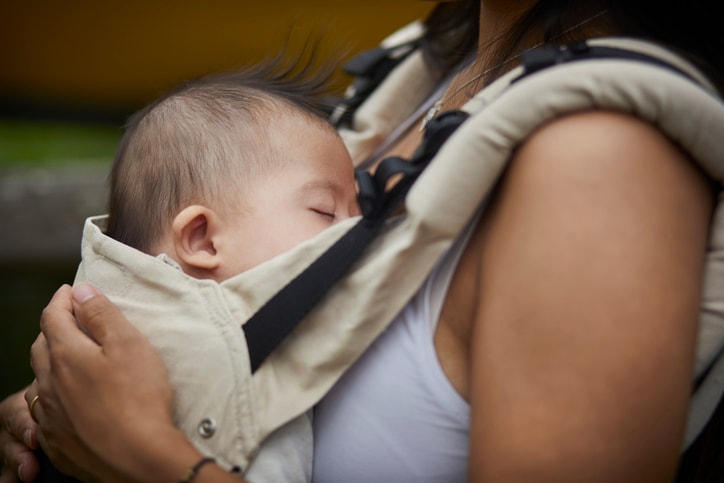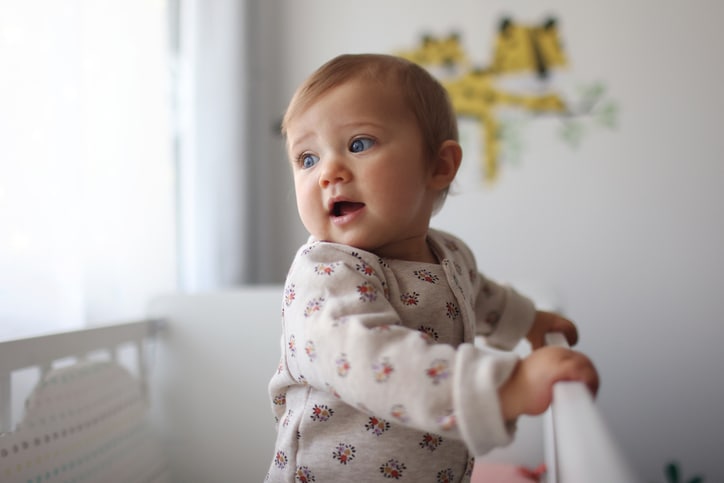Helicopter parenting. Free-range parenting. Gentle parenting. There’s a name for almost every type of parenting, but koala parenting — a new-ish parenting term — is currently having a moment. But what is koala parenting?
Koala parenting is a newer term for attachment parenting, a style of parenting first coined by pediatrician William Sears in 1982. “Attachment parenting is a parenting philosophy that proposes methods aiming to promote the attachment between parent and infant,” explains Dr. Steven Abelowitz, founder and medical director of Coastal Kids Pediatrics and medical director of Pediatric Associates. “It’s not only based on the core of parental empathy and responsiveness, but also emphasizes continuous bodily closeness and touch.”
“It’s not only based on the core of parental empathy and responsiveness, but also emphasizes continuous bodily closeness and touch.”
— DR. STEVEN ABELOWITZ, PEDIATRICIAN
While there are a number of ways for parents and their children to form an attachment, Sears’ specific recommendations (more on this shortly) resonate with many. “I was a new mom when I discovered attachment parenting through the works of Dr. William Sears,” says mom of five Bonnie Way, who runs the site, The Koala Mom. “His writings made sense to me because I could already see that my newborn wanted to be close to me at all times, and babywearing became an easy way to meet her needs and mine. She needed to be attached to me, and I needed to get the dishes or laundry done, so carrying her with me kept us both happy.”
Wondering about koala parenting and what it entails? Here’s everything you need to know.
What is the koala parenting approach?
The goal of attachment parenting, which is interchangeable with koala parenting, is to promote bonding between baby and parent through what Sears’ deemed the seven “Baby Bs.” They include:
- Birth bonding.
- Breastfeeding.
- Babywearing.
- Bedding close to the baby.
- Belief in the baby’s cry.
- Balance and boundaries
- Beware of baby trainers.
This specific parenting philosophy has been around for decades, but the term “koala parenting” is relatively new. Where did the phrase come from? It’s hard to say. (Some credit — who else? — Kim Kardashian for causing the term’s surge in popularity.) But as Way explains, the term’s evolution makes sense.
“The image of a mother koala represents attachment parenting well because when we think of koalas, we often think of a mama koala with babies either in her pouch or hanging off her back,” Way notes. “It’s a cute way to think of the closeness between mom and baby, and also the dependence of the baby on the mom.”
“The image of a mother koala represents attachment parenting well because when we think of koalas, we often think of a mama koala with babies either in her pouch or hanging off her back.”
— BONNIE WAY, PARENT AND BLOGGER
Pros and cons of koala parenting
There are a number of pros and cons to both the overall koala parenting philosophy, as well as some of Sears’ specific guidelines, according to doctors and parents. Here’s a look at a few.
Pros
Increased chances for breastfeeding success. For parents wishing to breastfeed, koala parenting, “encourages and enhances breastfeeding success,” Abelowitz says. This, in part, has to do with the emphasis that’s put on frequent touch and closeness.
Positive effects in child development. “Babywearing or placing baby in a front pouch as if to ‘wear’ them was initially recommended to help soothe crying infants,” notes Dr. Ronald Potocki, a pediatrician at Orlando Health Arnold Palmer Hospital for Children. “However, this practice has become a way for parents and infants to bond. Additionally, babywearing has proven to have a positive relationship on a child’s development and can decrease fussiness in infants.”
Decreased risk for SIDS. “One of the biggest risks to a newborn infant is the risk of SIDS or sudden infant death syndrome,” says Potocki. “This is usually caused by a lack of adherence to safe sleep guidelines, as published by the American Academy of Pediatrics. ‘Safe sleep’ means infants should be placed to sleep on their back on a flat surface, alone in a bassinet or crib, with nothing else in the crib, such as toys or stuffed animals. Part of the recommendations for safe sleep include having a bassinet or crib within a caretaker’s bedroom. This is commonly known as ‘room sharing.’ This practice of room sharing has proven to decrease or reduce the risk of SIDS.”
However, Potocki adds: “This does not mean that caretakers share the same sleeping surface as the infant, but rather the infant has its own space within a caretaker’s room.”
Increased emotional regulation. Koala, or attachment, parenting can “increase the development and learning of the skill of emotional regulation,” notes Abelowitz. “Some studies have found that infants exposed to a highly responsive parenting style, like attachment parenting, show less distress and further down the line may be able to better regulate their emotions such as fear, anger and distress.”
Better coping mechanisms. “This method of parenting can have the potential of exposing infants to less stress,” notes Abelowitz. “This can positively affect brain development and the ability to cope with stress later in life.”
Strengthened attachment even as kids grow. In addition to being able to tote her baby along while she ticked off chores, Way says koala parenting has paid off for her family in the long run, too. “I’ve noticed that all my babies crave closeness with me and are much calmer and easier to soothe when they are near,” she says. “This craving for closeness doesn’t end when your baby ceases to be carried. My five kids are now ages 4 to 14, and I find that they still all crave closeness with me, both physically and emotionally.”
“Much of what we might consider ‘bad behavior’ on the part of our kids is often simply them crying out for attention that we aren’t giving them,” she continues. “So when we meet their needs for closeness and emotional support first, they are happier and don’t need to act out to get attention — and that, in turn, makes parenting easier.”
“Much of what we might consider ‘bad behavior’ on the part of our kids is often simply them crying out for attention that we aren’t giving them.”
— BONNIE WAY, PARENT AND BLOGGER
Cons
There can be some downsides to some aspects of koala parenting, mostly when, as experts explain, it’s practiced incorrectly.
Risks that come with bed sharing, which is not recommended. “The most important and potentially very serious drawback of attachment parenting is if parents bed share,” Abelowitz says.“The risk of suffocation and SIDS is significantly higher with co-sleeping than it is with room sharing.”
Less sleep for parents. “One of the only drawbacks of room sharing that has been studied is the ability of an infant to sleep well and throughout the night,” Potocki notes. “It has been shown that an infant’s sleep can be erratic and irregular at times. This translates into the parent also having erratic and irregular periods of sleep which can take a toll on the caretaker’s mental and physical ability to provide for the newborn infant.”
Risks from babywearing not practiced correctly. Babywearing can be a great tool for both parents and baby — but only if done right,” notes Polocki. “One of the biggest drawbacks of babywearing is the concern for possible infant suffocation or asphyxiation,” he says. “This is particularly true in infants who are less than 4 months old as they do not have fully developed head control.”
“To prevent suffocation in infants less than 4 months of age, make sure infants are not wrapped too tightly, they are able to be always viewed by the caretaker and they are well supported without curling them into a C-position onto the chest,” Polocki continues. “This helps to prevent any airway obstruction which may lead to suffocation.”
Loss of autonomy, especially for primary caretakers. Depending on your family’s setup, this type of parenting can be very helpful … or the opposite. “Implementing attachment parenting can be potentially very demanding for parents from a physical and emotional standpoint,” Abelowitz says. “Many mothers may struggle with establishing their own healthy sleep patterns, returning to work or even maintaining the same level of intimacy with their partner at least for some time.”
“With attachment parenting, there is constant or almost always close physical contact and response to the infant’s demands, which can be extremely time consuming, as well as emotionally taxing for the parent,” Abelowitz continues. “It’s important to note, what works for one parent may not necessarily work for another.”
“With attachment parenting, there is constant or almost always close physical contact and response to the infant’s demands, which can be extremely time consuming, as well as emotionally taxing for the parent.”
— DR. STEVEN ABELOWITZ, PEDIATRICIAN
The bottom line
Just because koala parenting is an umbrella term for a number of specific practices, there’s no rule that says you have to incorporate them all. (In fact, you don’t have to incorporate “all” of any type of parenting style).
Say Abelowitz: “From a pediatrician and an evidence-based standpoint, there is really no established type of practice that parents need to follow pertaining to attachment — or koala — parenting.”






